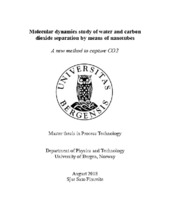| dc.description.abstract | Anthropogenic carbon dioxide (CO2) emissions are a huge concern these days. Arguably, but widely accepted, the apparent global climate changes are due to the increasing CO2 concentrations in the atmosphere. Carbon dioxide released into the atmosphere from combustion of fossil fuel (coal, oil and gas) can impact both local and global climate significantly. New technological solutions to capture the CO2 which are more energy efficient and less costly are necessary to mitigate the CO2 emissions. Substantial amount of CO2 can be distributed into water by high-shear hydrodynamic forces generated, for instance, by venture nozzles. In this process, supercritical components in flue gas, like nitrogen and oxygen, will easily be flushed off from the water/CO2 mix. Nanotube filtering of the remaining water/CO2 mix is an interesting alternative to conventional CO2 capture technology since water needs substantial space in order to arrange large hydrogen bonded network. This space is not available in small nanotubes. In this research project, molecular dynamics simulation of modelled systems is utilized to investigate separation of an inhomogeneous system of water and CO2 through nanotube filtering (separation). In order to accomplish this, a non-uniform system consisting of a container with aqueous water-CO2 mixture connected with a nanotube to a receiving tank with initially pure CO2 gas is modelled. This nonequilibrium system is thermostatted with a same reference temperature for both containers. The basic idea of the non-equilibrium system set-up is that the thermodynamic driving forces related to mechanical work and chemical work in the free energy for nanotube plus receiving tank will approach zero as quasi-equilibrium conditions are reached. At this stage, the pressure at the end of the nanotube and the receiving tank will be the same and the chemical potential for CO2 at the end of nanotube and tank will be equal. In addition of being a method for calculating chemical potential for CO2 in the nanotube, this setup is utilized to investigate capacity (flux) and selectivity for CO2 through the nanotubes. The new method to capture CO2 that will be presented in this master is based on separating the CO2 with carbon nanotubes from a non-equilibrium water-CO2 mixture (super-high concentrations of CO2 initially distributed in water). The simulations conducted in this research project are divided into two parts. In the first part, the selectivity and risk of water entrainment are evaluated as a function of nanotube size and initial pressure gradient across the nanotube. The second part uses a more idealized simulation system to evaluate the capacity of the nanotubes. The capacity of the nanotubes is quantified by CO2 flux through the nanotube as well as introducing an approach (briefly described above) that will be used to estimate the chemical potential of CO2 in the nanotube as a function of nanotube size and driving forces in the water-CO2 mixture container. By analysis of the simulation results in part 1, this new method to capture CO2 showed promising results with good CO2 selectivity and low water risk under the constraints of the simulation system. The CO2 molecules had a strong preference relative to water to be separated from the inhomogeneous water-CO2 mixture with adsorption into the non-polar carbon nanotube. The good CO2 selectivity was found to be highly governed by strong water-water hydrogen bonding network interactions, strong CO2-nanotube interactions and a high excess CO2 concentration in water bulk. By increasing the initial pressure (by reducing the initial volume of the water-CO2 mixture), the result was a higher flux of CO2 into the nanotube, but also a higher risk of water entrainment, but still, the water was highly discriminated by the nanotube. In part 2, it was found that a large increase in the thermodynamic driving forces resulted in a much higher flux through the nanotube as well as a dramatically higher number of CO2 molecules in the receiving tank. This is a very encouraging result because it shows the high potential (with high flux) of nanotube for the separation process if there is a high-density region of CO2 in the water-CO2 mixture near the nanotube entrance. A simulation system was successfully designed to give a first time ever estimation of the chemical potential of CO2 in the nanotube under the constraints of the system. In both part 1 and 2, two 6 nm long nanotubes were investigated. That is: a (10,10) nanotube (1.3 nm in diameter) and a (20,20) nanotube (2.5 nm in diameter). Due to the small margin in the results and the constraints of the system, the results cannot be used to conclude which nanotube size that resulted in the best CO2 selectivity and flux through the nanotube. However, in part 2, the (20,20) nanotube yielded a much faster CO2 flux the first ~5 ns of simulation, but in the end, both nanotubes ended up with about the same amount of CO2 molecules passing through the nanotube for the same driving force conditions. | en_US |
